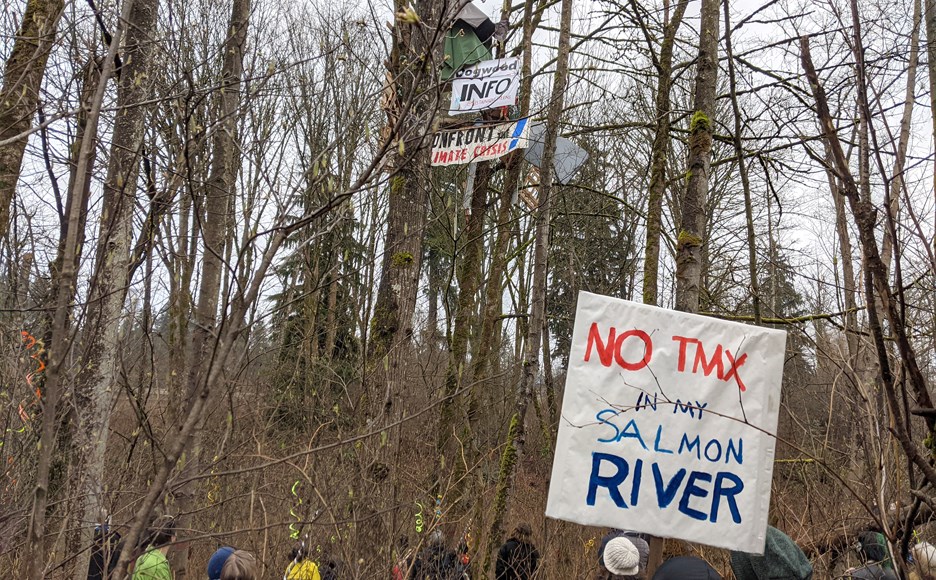Editor:
I wrote to Ian Anderson, CEO of Trans Mountain pipeline, on 30 January 2021 about his company’s plan to cut 1000+ trees along the pipeline right-of-way in Burnaby (copying Mayor Mike Hurley). I included a low-res image of a heron waiting patiently in Stoney Creek to catch a fish while TMP’s survey crews were preparing the area for a creek-crossing on 16 January 2021. I received a detailed reply from Anderson on 17 March; he saw the heron and said he understood its significance.
This comment today is about what Anderson said in his reply to me, and did not say. I am replying directly to him today to say that I am pleased to read in his letter about the many ecological values we have in common, especially if and when they are translated into practice on the ground. In this comment today in Burnaby NOW, I’m focusing on the TMP’s impact on Burnaby’s trees.
Since I wrote to Ian Anderson at TMP specifically about the removal of 1000+ significant trees along the right-of-way, I looked for his 17 March statement to me about precisely how the ecological services provided by those trees would be replaced, where the new ultimately-significant trees would be planted, and in what numbers? The ecological services those trees provide are homes for birds, stabilize the landscape, they absorb CO2 and release oxygen, they create vast essential below-ground insect communities, and sustain wildlife of all kinds. Since the TMP’s Reclamation Management Plan is a good one, I wrote to Mr Anderson to suggest more focus on replacement (reforestation) on the edges of the right-of-way. His letter states however:
“It is important to recognize that trees removed for the pipeline easement (the minimum 6 m wide right of way area required for pipeline operations) will not have replacement trees. The reclaimed pipeline easement will be revegetated with native species. For areas along the edges of the pipeline easement, low-growing woody shrub species will also be installed following natural patterns and cover.”
Low-growing woody shrubs on the edges of the easement may be appropriate for some sections, but surely not for all? The result of this deforestation should be, in my opinion, a number of cluster-plantings on or near the right-of-way-edges which would constitute (in 10 years) the nucleus of small woods. A thousand+ trees reintroduced would create ten clusters of a hundred trees, or five clusters of two hundred trees, etc. This would require monitoring and nurturing those significant-tree clusters for the first 5 years, a monitoring period that Ian Anderson noted TMP is committed to. We need to talk about a net balance in which 1000+ significant trees are growing strong five years after 1000+ trees have been cut for the pipeline.
Equally important, it is not just the details of the necessary removal of significant trees from the right-of-way which I am asking TMP to focus on, but also stopping the further degradation of the broad ecosystem services these trees provide, a process which can be reversed by TMP’s on-the-ground practice.
That is how I translate the high values of his excellent letter into sustainable practice; he says “we value the environment and are focused on preserving it for future generations.”
Great care should be taken to counteract the well-known “edge effect” in which degradation creeps and spreads well beyond the legal boundary line which the TMX cutting crews will follow. The technical literature is rich on this creeping-degradation edge effect. The introduction of invasive plants is almost inevitable, and the clearing will further fragment an already very fragmented ecosystem. That clearing boundary line both opens up to new ecologies and closes down existing ones. I am asking that TMX will pay careful attention to this issue. Skillful new plantings and removals could strengthen the edge of the pipeline, not weaken it.
As proof of this concept of strengthening ecosystems in Burnaby, I am reforesting parts of disturbed land adjacent to our house which are old sewer rights-of-way, unbuilt street terrain, previously logged-off areas, refinery buffer- zones etc. I am quietly enhancing the ecological services of these lands, the value of which will be known only to others after my death. My grandchildren will play in these woods just as surely as the herons and eagles will nest in those trees I have planted or salvaged. The ecological system has a wisdom quite different from our lines on the ground. The 1000+ TMP trees when planted anywhere in Burnaby will benefit us all, creating complex systems below and above ground. If there is insufficient room at the edges of the right of way surely we can look together for other spaces?
I copied Mayor Mike Hurley on my 30 January letter and I am glad to say that the mayor informs me that he considers the scale of the right-of-way deforestation to be an important issue which calls for a solution. He wrote to me on 18 March: “I wholeheartedly agree with you that the loss of a large number of trees would have negative impact to surrounding ecology and wildlife, and this needs to be addressed by Trans Mountain.”
Robert Anderson, Burnaby


